When it comes to popular culture, there’s a Japanese twist to nigh everything. Such as game shows. Can’t beat some classic Takeshi’s Castle! Or reality shows. Because be honest – who hasn’t watched back Nasubi’s outrageous 15-month televised ordeal stuck alone, in a single room, living off sweepstakes prizes? There was even a documentary. And stamps. Yes, stamps.
Gotta collect ’em all! But not in the peel ’em from a postcard and slide ’em gently into a collectors’ album with a pair of tweezers kind of way. No, so-called “Stamp Rallies” are a different animal. A quintessentially Japanese phenomenon, the Stamp Rally (スタンプラリー) foundations were laid in 1931, when a train station in Fukui allegedly installed a commemorative stamp booth in a bid to lure more tourists to the city. Other railway stations followed suit, and soon enough, one could stage an elaborate in-life collectathon by bouncing from railway to railway (or metro to metro) station to fill one’s special stamp book with inky effigies. The Stamp Rally was born.1Even the term “Stamp Rally” is a Japanese wasei-eigo, or made-up loanword-alike.
Stamp Rally
Fast-forward some ninety-odd years and stamp rallies have become a cultural institution, ubiquitous in the private and public sectors in a broad range of guises. Take the Japan Castle Foundation, for example, which offers a highly official “24 Best Castles Rally” that wants you to hit up two dozen strongholds scattered across the Japanese islands.2See: https://japanese-castle.com/en/about-us-en (What I’d give to partake!) Supermarkets join in, with convenience store chain 7-Eleven regularly treating customers to one pop culture rally or another. Even municipal and city governments send tourists on wild goose chases around local sights to collect inksmears on paper. And recently, the stamp rally has become an export, with Nintendo porting its Animal Crossing in-game museum stamp rally to the real world by bringing it to select aquariums in Japan, the United States, and Europe.
The stamp rally gold standard however, is collaboration between transport companies and popular franchises. The examples are countess. Think Tokyo Metro × Studio Ghibli in 2023 (here) that resulted in lavishly decorated trainsets and free stickers. Or the extremely oversubscribed Seibu Railway × Yo-Kai Watch rally in 2014 (here) that led to prize card shortages and extremely long queues.3See: https://toyokeizai.net/articles/-/45074
Still, the most famous partnership has to be the Japan Rail (JR) × Pokémon tag team. Nearly every Summer holiday season, the pair join forces to send participants around Greater Tokyo and beyond to collect inkdots in exchange for merchandise, goodies, and miscellaneous paraphernalia. Take the maiden Summer 1997 JR East Pokémon Stamp Rally, for example, that gave out up to 100.000, non-glossy copies of promos Surfing Pikachu and Lilypad Mew. Or more recently, the 2023 JR East Yokohama World Championships Rally (here and here) that gifted travellers who completed it a postcard, folder and tote bag. In one unique instance, JR Kyushu’s Stamp Rally even featured digital event Pokémon, downloadable over WiFi in transit between major Kyushu cities – Pokémon that moreover responsively took the nearest railway hub for their parent names (Nagasaki Sceptile, Sasebo Metagross, Kagoshima Blaziken, and so on). It was delightfully quirky; I shall write about it someday.
You’ll gather, then, that there are no limitations to the many forms a stamp rally and its rewards can take. And I’ll get to the point. Like Japan Rail, Shogakukan – publisher of CoroCoro Comic, among others – has engaged in its fair share of stamp rallies in partnership with Pokémon over the years. Not of the inky variant, but the lickable kind.
Stamps × Pokémon
The first of these Shogakukan-sponsored postage-stamp not inky-stamp campaigns took place throughout the Spring and Summer 1997.4Thus overlapping JR East’s maiden Poké-Rally, attentive readers might note. For whatever reason, it wasn’t the publisher’s flagship magazine (CoroCoro Comic) that played host to this initiative, but rather the fantastically prolix Grade-Specific Learning Magazines (GSLM). What on earth are those, you ask? Essentially, for decades, Shogakukan published six parallel animanga magazines each month tailored towards grade levels (“years”) one through six, their content tweaked according to the presumed interests and reading comprehension of the target demographic.
Pokémon content featured regularly in all of these, and in April 1997, readers of the Year 3 issue discovered a surprise announcement for the start of a six-month, consecutive issue stamp rally dubbed the Pokémon Stamp Collection World campaign.5「ポケモンスタンプコレクションワールド大公開!!」 A Charmander stamp sheet was enclosed, and a two-page spread encouraged children to look (見), cut (切), paste (貼) and glue (湖) their stamps into the Charizard-themed stockbook to follow in May’s issue. Said Year 3 issue also carried a Squirtle stamp sheet; Clefable, Bulbasaur, Raichu and finally Mew sheets followed in September to close out the campaign.6See: https://dl.ndl.go.jp/pid/1743690 If students wished to complete their stock books and collect all of the 151 Pokemon known to the world in stamp form, they simply had to procure all the relevant issues of Learning Magazine. Quite the business model!

Shogakukan Learning Magazine Year 3, April 1997. Via @poken_kibou here.
Two things are important to our story here. First, by succesfully testing the waters, this 1997 stamp rally opened the doors to further Poké-stamp campaigns reaching well into the 2000s. Second, if you study the above Year 3 two-pager carefully, you’ll notice the repeated appearance of a white-bearded dude with sunglasses and black, wide-brimmed hat, arm wrapped around a Chonkachu. This mysterious figure is the Daisuki Club Chairman, or Kaichou (会長), and his preposterous attire notwithstanding, he is the subject of this stamp campaign’s most enduring mystery. More on that later.
Promotions and Prizes
For now, let’s skip ahead a few annums to Spring 2003 to find the Learning Magazines in the throes of yet another Pokémon stamp rally. As May 2003’s Year 2 issue made clear on a two-page spread titled “Special Grade Pokémon Stamps”,7「ポケモンスタンプ特級」, p23-25. Years 1 and 3-6 presumably carried a similar announcement. each consecutive GSLM issue of any grade published between May and September would carry one of five stamp sheets themed around Kyogre, Groudon, Latios, Latias or Jirachi, to be pasted in a stock book included in June’s issue. The paper-rally core concept, then, remained unchanged from six years prior – buy magazines, paste stamps, complete stock book. This time, however, a cornucopia of potential prizes awaited the dedicated Pokéfans who went all the way.

Grade-Specific Learning Magazine, Year 2, June 2003, p.50-51. ICanSnake’s collection.
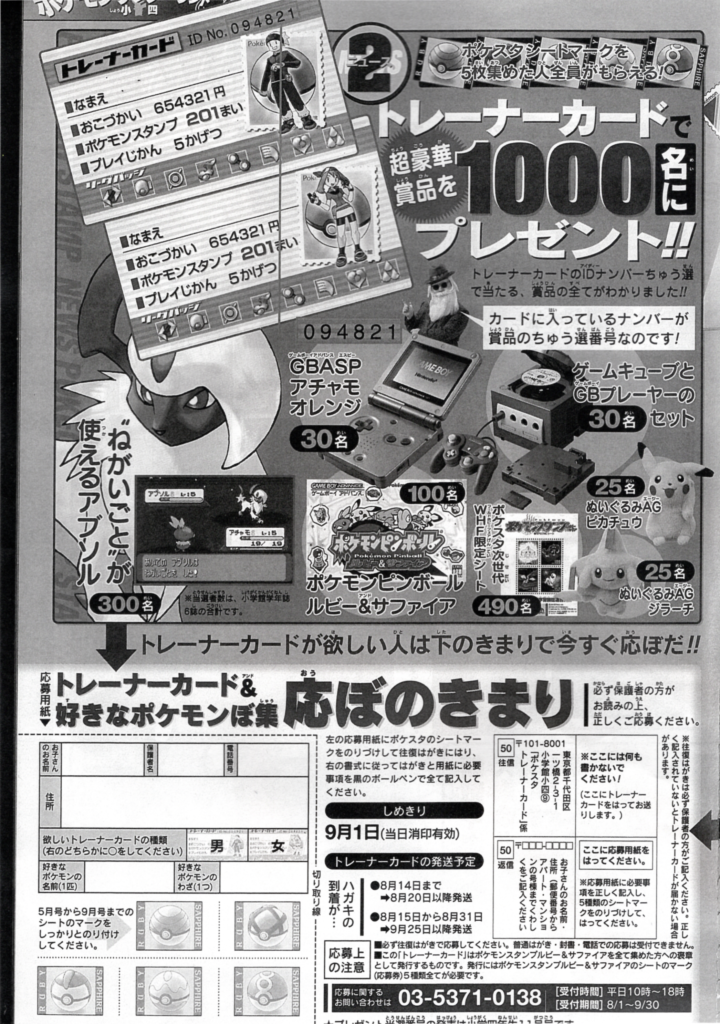
Grade-Specific Learning Magazine, Year 4, September 2003, p.15
A reward pool of one thousand prizes, to be exact. Luckily for us, the Year 4 September 2003 issue provided a visual of the hot items up for grabs.8 Originally in colour, we acquired grayscale photocopies. I’ll walk you through them. As a consolation prize, 490 winners would get limited edition World Hobby Fair 2×2 stamp sheets featuring Jirachi, Groudon, Flygon and Absol. A tier above that, 25 successful submissions stood to receive a chunky Pikachu plushie while another 25 could look forward to a Jirachi plush. Factory-fresh copies of Pokémon Pinball: Ruby & Sapphire awaited 100 winners. And incredibly, in what we may assume were the grand prizes, 30 lucky souls would be blessed with a shiny new Torchic Orange GBA SP, while another 30 would find flashy spice orange Nintendo GameCube and Gameboy Player sets on their doorsteps. In this manner, altogether 700 prizes… Oh, hang on. There were also 300 Absol event Pokémon on the menu!
Now, before we turn to Absol itself, let’s quickly investigate how the prize application and award processes worked – topics which we’ve artfully glossed over so far, because the details are a little fuzzy. As can be seen in practically all the promotional material released for the campaign, facsimile Ruby & Sapphire Trainer Cards were central to the whole shebang. We’ve already discussed how issues of GSLM came with five different stamp sheets through May-September 1997, each containing some 40 unique, numbered stamps with pictures of 201 total Pokémon on them.9What issues of Learning contained what sheets each month is an open question. Assumed is an offset rotational pattern ending in September’s Jirachi for all. At the very bottom of each sheet, right in the middle, stamp-enthousiasts could find one of five different, extricable (Poké)ball marks: Timer, Net, Dive, Nest and Repeat. These, in turn, could be pasted onto the reserved squares of a Trainer ID and prize contest submission form included in the September 2003 issues of all GSLM years. Successful applicants were guaranteed to receive back a stylish, Daisuki Club-issued Trainer Card. In the vein of the Pokémon video games, the front showed a boy/girl portrait against a Pokéball backdrop, confirmed one’s stamp collection status (201 caught), and offered a blank space to write one’s name. Meanwhile, the reverse had the Daisuki Club logo, a portrait of the Kaichou, and text that certified one’s stamp collection achievement replete with Chairman signature. Cool, huh!
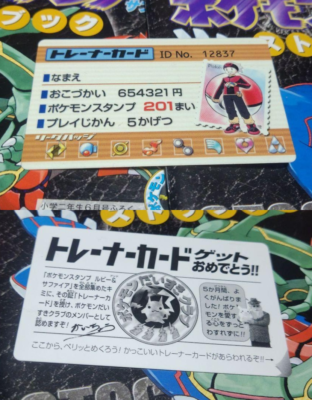
Contest Trainer Card, obverse and reverse. TID is #12837, the highest known.
By applying for a Trainer Card, participants automatically entered the pool of potential prize winners. Key here is the unique six-digit TID printed in the top-right corner of every Trainer Card. This string of numbers wasn’t there just for showy consistency with the video games; rather, they were contest-pertinent, used to draw 1000 winners from the – unquestionably – very large pool of applicants (at least 12837, if we assume that TIDs were generated sequentially).10Evidently cherished mementos, pictures of quite a few Trainer Cards float around on the web. The highest such known TID is #12837, as can be seen here. TID #12715 is here. Unfortunately, the ins and outs of the lottery proceedings aren’t known to us. Whether a thousand unique combinations were selected by random number generator, random sampling was foisted on all generated TIDs, or a preconstructed list of winning digits was used – who knows. It is apparent that a list of winning TIDs – possibly all 1000, but at least the grand prizes – was published in the November 2003 issues of Learning, but as much as I’d like to beat you over the head with an exhaustive enumeration of all (Absol) winners, we presently don’t have access to this information. As such, we also don’t know if prizes – and Absol in particular – were awarded equally across grades, ie. fifty Absol for each of Year 1-6, or whether a genuine randomness precluded this. So, for now, we must put a pin in all these questions.
Right. Admittedly, Pokémon giveaways are a dime a dozen, but the serious tech on offer in this Shogakukan collaboration comfortably put it on par with the spectacular giveaways that the Daisuki Club would soon be renowned for.11See here, for example: https://console-test-universe.jimdoweb.com/nintendo/nintendo-ds-lite/page-2 It shan’t surprise you, then, that the free-of-charge periodical Pokémon Scoop saw fit to promote this particular stamp rally in its Summer 2003 issue (that was likely published sometime in mid-late June of that year).
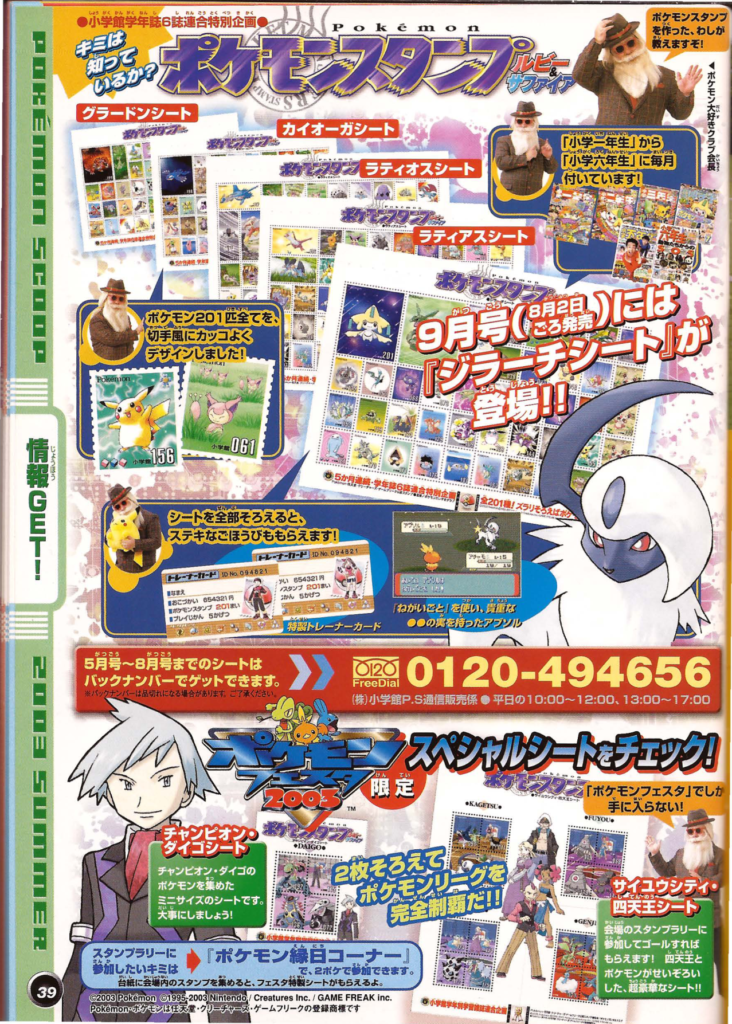
Pokémon Scoop – Summer 2003, p.39. Coconut LaCroix’s collection.
Upon examination of this mini-mag, we find that colourful images of the campaign’s various stamp sheets dominated p.39. Here, too, the Daisuki Club Chairman showed his face (or, well, his impressive beardstache); through several textboxes, the tweed-wearing, Pikachu-hugging, ever-helpful Kaichou explained in the briefest of fashions what issues of GSLM to purchase to acquire the coveted stamps, articulated the elegant design of the collectable paper specimens, and instructed readers how to apply for prizes – even if the advert puzzlingly neglected to mention what those prizes entailed. Hmm. I can only imagine that the issue’s editors ran out of print space, perhaps owing to a conspicuously sizeable bright-red banner that encouraged readers to order back issues of May-August’s Learning Magazines by dialling 0120-494656 (10-12AM, 1-5PM workdays only). The page did, however, include a commanding portrait of a rather surly-looking Absol in the lower-right, and moreover teased that – spoilers! – Absol would know a unique move (Wish) and would come holding something special, but fell short of saying what.
I assumed that parent magazine CoroCoro Comic, too, would have sought to heavily cross-promote the GSLM stamp campaign. But the opposite is true, and when browsing its various Spring-Autumn 2003 issues, it’s easy to see why the flagship publication was a tad preoccupied. For one thing, CoroCoro kept exceptionally busy showcasing the new Pokemon movie Seven Nights: Jirachi, set to release July 19, 2003. Page after page (p)reviewed Jirachi’s film exploits, and each of the May through September issues predictably featured the Wish Pokémon on its cover. Meanwhile, the Pokémon TCG – which had rolled into the novel ADV era – got pushed exceptionally hard, with spread after spread in consecutive magazines. And insofar as CoroCoro focussed on event Pokémon, movie tie-in “Wishing Star Jirachi” understandably took centre stage, available as it was primarily through commercially-interesting advance ticket purchases.12Another 70.000 could win it by lottery at Festa 2003, another 10.000 at World Hobby Fair 2003, and another 500 through a September 2003 CoroCoro lottery. Even the unusual PokéCenter egg distribution known as “PCJP03” (which featured not one, but two unique Absols), made do with a measly quarter page in the June 2003 issue. Amidst this onslaught, the stamp campaign’s sole mention (that we could find) came in that same June 2003 issue on an unknown grayscale page, because the incredible resource that is Zoidsland failed to photograph the page number. In any event, a header that read “Five Super-Effective Major Pokémon Features”13「超こうかポケモン5大特集」 listed the stamp campaign’s release of the Groudon sheet as the #1 item to watch alongside, among others, the conclusion of the Ruby & Sapphire manga and Daisuki Club Wishmaker movie news. To sum up: The intuitive assumption that CoroCoro Comic aided in the promotion and/or distribution of stamp sheets appears to be false. The rally, then, was a strictly Learning Magazine-based affair.
A Tale of Two Brothers
Let’s make one last digression. We’ve so far spoken of the Chairman in the singular. However, those familiar with the many generations of Pokémon games will know that this is a convenient fiction: There exist a plurality of Chairmen, with each region – Kanto, Johto, Hoenn and so on – having its own in-game Fan Club Kaichou that invariably rambles about his affection for this Pokémon or another and as a gesture of appreciation might present you with, say, a Bike Voucher, Rare Candy or Contest Scarf.
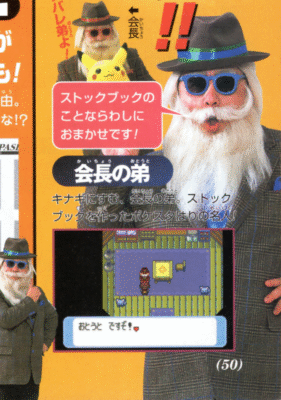
Grade-Specific Learning Magazine, Year 2, June 2003, p.50. ICanSnake’s collection.
Now, since the Absol & Pichu Stamp promotions coincided with Ruby & Sapphire, this particular iteration of the Chairman is obviously Hoenn’s. Yet there is a further complication. Those who study the promotional materials in this article carefully will notice that the bearded figure sometimes dons a red-rimmed hat and red shades, and at other times a blue fedora and blue sunglasses. This is because, in fact, these subtle colour differences are meant to indicate two different personae. The gentleman in red represents Hoenn’s Fan Club Chairman resident in Slateport City. The blue headwear senior citizen, on the other hand, is the Chairman’s younger brother, who calls Pacifidlog Town his home. GSLM saw fit to clarify the difference, and the Chairman can be seen encouraging his sibling (ガンバレ弟よ) in the Year 2, June 2003 issue (p.50). The page even included a Ruby/Sapphire screenshot where the Chairman proclaims to have a sibling.
In general, the entirety of the promotional paperwork reveals that the siblings worked together to communicate the essentials of contest participation and prize distribution. But all this begs the question: Why? Why this elaborate plot device when a solitary no-frills Kaichou could have anchored the distribution just fine? I find this incredibly intriguing, but to the extent that we succeed in cracking this tantalising origin story mystery, we shall save it for our Pichu article. Know for now that in the context of Stamp Absol and Pichu, these Hoenn-based fellas made a team, and that when we speak of the Kaichou, we speak of a duality.
Absol, But Whose?
Alright, let us at last shift focus to Absol itself. Which raises two immediate questions: Why go through the trouble of putting an event Pokémon in the prize pool that required the 300 victorious players to ship their cartridges by mail, thus creating a logistical nightmare on top of already complex prize-giving procedures? And, why Absol? Thankfully, to answer the second question is to answer the first.
In terms of monetary value, a simple event Pokémon could not compete with the top rally prizes of a Nintendo GameCube or flashy Torchic GBA SP. Yet the rally did its utmost to frame Absol as uniquely desirable, and as such, the doomcat’s artwork appeared in much of the campaign’s GSLM and Scoop promotional material. If you’ve seen Jirachi: Wish Maker, you’ll understand that the choice of Absol wasn’t exactly coincidental. In the film, a vigilant Absol attempts to warn Ash & pals of antagonist Butler’s nefarious schemes on the oblivious Jirachi, but is wrongfully perceived to be an enemy. This role of misunderstood watchman fit Absol to a tee and indubitably made him super cool. It made sense, then, to leverage what was expected to be a popular character. In other words, Absol was picked to be a second, pseudo movie tie-in; a random chance companion to the guarantees of preorder Jirachi.
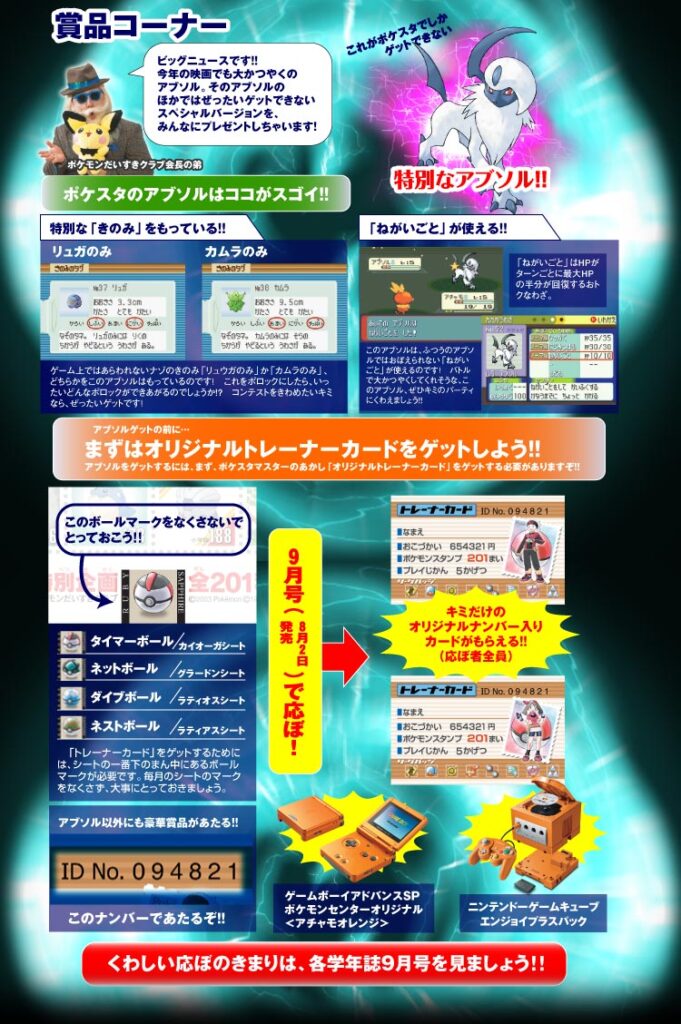
Shogakukan’s “Prize Corner” Absol website.
But don’t just take my word for it: Have a look at the dedicated “Prize Corner” website set up specifically to publicise Absol. First captured by archival crawlers on June 22, 2003, we may assume that the site went live around early-to-mid April, when the first batch of GSLM issues carrying the stamp promotion hit boutiques across Japan. Another capture from August 10 reveals the full website – and what a treat it is! In the top-left, we spy the usual suspect the Chairman, yapping away about Absol’s major role in the film and the special, exclusive event Pokémon designed after it. A box inset then revealed Absol’s held item: a Salac or Ganlon Berry, and explained their rarity and utility in making contest-worthy Pokéblocks in Ruby & Sapphire. Over to the side, the infographic highlighted Absol’s unique Wish move, sure to be a great help in battle. (Note the similarities to the 2004 Box Distribution at PokéCenter New York). Below that, the image explained in detail how to apply for Absol. Note also how the website listed only four ballmarks instead of the five required for a complete entry. Why, I’m not sure; it’s conceivable that Jirachi was a last-minute addition, but I deem it more likely that the Jirachi sheet’s inclusion in the September issue was, at this stage of the campaign, intended to be a surprise sprung at the height of the Wish Maker film hype.
Now, informative as this infographic was, in retrospect, it’s more notable for everything it did not say as much as what it said. In fact, nowhere in any of the campaign’s promotional materials can we discern two extremely pertinent pieces of information: Absol’s Original Trainer Name (OTN) and Trainer ID (TID). This, in turn, has fuelled one of the event scene’s most enduring mysteries. What exactly did this Absol look like?
There’s a clear reason why throughout this article, I’ve repeatedly emphasised the presence of the white-bearded, sunglasses-rocking Daisuki Club Chairman in various rally-related materials. In August 2024, popular Japanese YouTuber Kenzou Suzuki (鈴木けんぞう) posted a basic information video that covered the Shogakukan × Pokémon stamp campaign(s). Not all of it was accurate. In fact, perhaps owing to these inaccuracies, several prize-win claimants came forward to set the record straight, posting pictures of their Pokémon to Twitter (e.g. here). In this manner, we learned that the correct OTN of Absol’s 2004 successor, Stamp Pichu, is not in fact 「スタンプ」 (Stamp) as previously thought. Rather, it must be 「カイチョウ」 (Kaichou), who is of course the befuddled Pi(ka)chu-hugging Chairman.14“Kaichou” could theoretically be plural, as in, “the Chairmen“, referring to Hoenn’s Slateport Fan Club Chairman and his Pacifidlog brother. This was a truly unprecedented, dogma-shattering discovery. Twenty-plus years after the fact, new information had come to light. (Remember, we’re dealing with preposterously small sample sizes!) But what, then, of Absol?
For aeons, it was widely accepted that the correct OTN of GSLM Absol too must be 「スタンプ」 (Stamp) with a TID 30821, for August 21, 2003. Yet this established OTN/TID combo may prove to be entirely fictitious; a case of dogma unchallenged in the absence of credible evidence. For one, we can glean no particular significance to an August 21 date from any of the stamp rally’s promotional materials or, for that matter, from any Wish Maker movie-related information. Pichu’s TID is confirmed to be 31031, or October 31, 2003, which is the day immediately prior to the publication of GSLM’s December issue that included submission forms for the Pichu prize. If we apply the same logic to Absol, it yields a TID of 30731 or possibly 30801 for August 1, 2003 (September’s GSLM came out the following day). But is this actually the case? We don’t know!

Kaichou Absol. Genuine or not?
And concerning Trainer Name – now that we’ve, without a shadow of a doubt, established that Pichu’s OTN must be “Chairman”, the debate about Absol’s OTN has been blown wide open. Unfortunately, no Absol winners came forward in response to Kenzou’s YouTube video. Which leaves us to engage in some informed Trainer Name guesswork. To be sure, generic Trainer Name “Stamp” is still a distinct if dull possibility. Reflective of the campaign’s core mission, this conventional wisdom is the bookmaker’s choice. I’d like to raise an outside bet: 「ファウンス」(Fauns), for Forina, the mountainous terrain in Wish Maker beneath which Jirachi hibernates, and which guardian Absol calls home. Remember, this distribution is a quasi movie tie-in (the Chairman said so on the website!), and there’s even a Forina’s Absol TCG card to set an – admittedly weak – precedent. Lately, however, promising signs here point to “Kaichou” as Absol’s true OTN. Now, in no rally-related imagery can the Chairman be seen stroking, hugging, caressing, fawning over, idolising or otherwise showing affection for Absol. Quite the opposite – the Chairman appeared decidedly unmoved by the frequent inclusion of the same, singular Absol stock artwork in his infographics. We used to believe, then, that terms of likelihood, OTN “Kaichou” didn’t score very high. But then this 2014 tweet surfaced, appearing to show an original Kaichou Absol. What do you think? Is this Absol genuine, or is it a classic forgery? Ultimately, we simply don’t know, so I’ll let you, the reader, be the judge.
So! Enough said about Absol. Let’s proceed to act two of the Shogakukan × Pokémon Stamp Rally in part two to this series: Stamp “Kaichou” Pichu. (COMING SOON!)
- Harvest Moon 3 (2001) - March 5, 2020
- Pokémon Trading Card Game 2 (2001) - February 5, 2020
- Yu-Gi-Oh! Dark Duel Stories (2002) - January 5, 2020
